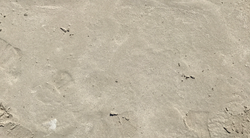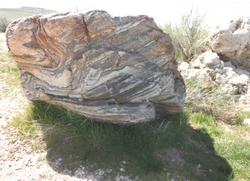
The Geology of Antelope Island
Assignment Reflection
Antelope Island is home to many unique and interesting geological features like tufa, gneiss, Tintic Quartzite, conglomerate, slate and oolitic sand. Antelope island has a rich geological history as evidenced by various ways in which these features formed. One of the more recent major geological events giving rise to some of the rock formations on Antelope Island was Lake Bonneville. For example, tufa, a porous rock made of calcium carbonate, formed during the Lake Bonneville geological event. In contrast, other rocks like gneiss and Tintic Quartzite formed millions of years prior to the Lake Bonneville event. Conglomerate, while also being formed in the more recent era, consists of pebbles from ancient era rocks like slate. Oolitic sand is the most unique geological feature on the island (Antelope Island State Park, 2017). This research paper will analyze the above geological features in more detail, as well as a providing a short summary of the human historic significance of Antelope Island.
First, tufa is a porous looking rock and is the youngest type of rock on the island (Figure 4). It was deposited by Lake Bonneville 10,000 to 15,000 years ago (Utah State Parks, 2015). You can find tufa at the shorelines of the ancient Lake Bonneville (Fox, 2011). Tufa was formed from calcium saturated waves hitting the limestone rock surrounding Lake Bonneville. The water would penetrate the limestone, precipitate out and create tufa (Antelope Island State Park, 2017). The tufa found on the ancient shores of Lake Bonneville have been used to carbon date Lake Bonneville’s increases and decreases in water level over time (Fox, 2011).
Second, gneiss is the oldest type of rock on the island (Figure 3). Some gneiss rock is 2.7 billion years old dating back to the earliest ages of dinosaurs (Antelope Island State Park, 2017). These rocks are also the same age as some of the rocks found at the bottom of the Grand Canyon (Utah State Parks, 2015). There are over seven types of gneiss rock on Antelope Island, resulting in it being the most common type of rock on the island (U., & U., 2017). Banded gneiss is found in the central and eastern parts of the island and is the dominant type of gneiss rock in both regions. Granitic gneiss is found in the west-central part of the island in large spread out masses. Granitic gneiss is usually surrounded by a small cluster or clusters of banded gneiss. All types of gneiss are igneous rock types and were formed at high temperatures (Willis, et al., 2000).
Third, Tintic Quartzite is spread out in small to large clusters around the entire island but is more dominant in the northern regions (Willis, et al., 2000). These rock clusters can reach a height of 800+ ft. and can be up to 245+ m thick. Tintic Quartzite usually consists of dense quartzite with the occasional mix of pale green coarse-grained quartzite and metaconglomerate (U., & U., 2017). Depending on the mixture, Tintic Quartzite can have a different color scheme ranging from light grayish-pink to a light-medium orange (Figure 5). The oldest recorded Tintic Quartzite on the island was deposited in a shallow marine environment dating back to 550 million years (Utah State Parks, 2015).
Fourth, conglomerate, slate and pale green quartzite are the less common rocks on the island (Figure 6). Interestingly, metaconglomerate and pale green quartzite play a big role in the composition and coloring of Tintic Quartzite. Conglomerate itself is made up of pebbles and gravel from ancient rocks like slate, dolomite, and diamictite that have been broken down over time (Antelope Island State Park, 2017).
Fifth, oolitic sand is unique for one reason; it’s not very common in the geologic world. Antelope Island is one of the few places oolitic sand is found but it can also be found on the beaches of Indonesia, the Persian Gulf, the east coast of Florida and the Bahamas (Antelope Island State Park, 2017). There are two significant differences between oolitic sand and normal sand. First, normal sand forms from the breakdown of larger rocks that are then deposited into a different area. In contrast, oolitic sand forms from thin layers of calcium carbonate around tiny particles (Antelope Island State Park, 2017). Secondly, normal sand has rough irregular edges while oolitic sand is round and smooth and usually oval shaped (Figures 1 and 2). Most of the oolitic sand can be found on the northern and western beaches of the island (Willis, et al., 2000).
While Antelope Island has an important and interesting geological history, it also has a significant human history. In 1843, John C. Fremont led the first scientific exploration of The Great Salt Lake which included Antelope Island. He named the island after its large population of antelope. Later in 1847 Mormon Pioneers took advantage of the wide open green fields on the island and used the fields for cattle grazing. From 1854 to1858 Brigham Young owned a steam boat named “Timely Gull” that he used for shuttling livestock back and fourth from Antelope Island to and from the mainland. In 1871, many people envied Young and some followed in Young’s footsteps by creating the largest steamboat (at the time) named “City of Corinne.” This steamboat was used for transporting goods and later for transporting people who wanted to travel to the resorts around the lake. (Antelope Island State Park, 2017).
Antelope Island is rich in its geological and human history. The island has aspects of geology that are unique to Utah and the world from its rare oolitic sand, beautiful Tintic Quartzite masses, multiple banded and granitic gneiss clusters, ancient Lake Bonneville tufa and different sized conglomerate. The human history aspect of Antelope Island shows the benefits and uses of the island in the past from cattle grazing to giant steamboat shuttling. Overall, Antelope Island has a diverse history and beautiful geological formations.
References
Antelope Island State Park. (2017). What's the Difference?. Display panels at the Antelope Island State Park Visitor Center observed on April 1, 2017.
Antelope Island State Park. (2017). Pioneers and Homesteaders. Display panels at the Antelope Island State Park Visitor Center observed on April 1, 2017.
Antelope Island State Park. (2017). The Youngest. Display panels at the Antelope Island State Park Visitor Center observed on April 1, 2017.
Antelope Island State Park. (2017). In Between. Display panels at the Antelope Island State Park Visitor Center observed on April 1, 2017.
Antelope Island State Park. (2017). Lots of Others. Display panels at the Antelope Island State Park Visitor Center observed on April 1, 2017.
Fox, D. (2011, November 07). Utah's ancient Lake Bonneville holds clues to the West's changing climate. Retrieved from http://www.hcn.org/issues/43.18/utahs-ancient-lake-bonneville-holds-clues-to-the-wests-changing-climate?b_start%3Aint=4#body
Hunt, C. B., Varnes, H. D., & Thomas, H. E. (1953). Lake Bonneville; geology of northern Utah Valley, Utah (No. 257-A).
Kahle, C. F. (1974). Ooids from Great Salt Lake, Utah, as an analogue for the genesis and diagenesis of ooids in marine limestones. Journal of Sedimentary Research, 44(1).
Miller, R. D., Olson, H. W., Erickson, G. S., Miller, C. H., & Odum, J. K. (1981). Basic data report of selected samples collected from six test holes at five sites in the Great Salt Lake and Utah Lake valleys, Utah (No.81-179). US Geological Survey,.
U., & U. (n.d.). Geological Map of Antelope Island. 1-2. Retrieved April 11, 2017, from http://files.geology.utah.gov/maps/geomap/parkmaps/pdf/M-127.pdf
Utah State Parks. Antelope Island State Park. N.p.: Utah State Parks, 2015. Print.
Yonkee, W. A., Willis, G. C., & Doelling, H. H. (2000). Petrology and Geologic History of the Precambrian Farmington Canyon Complex, Antelope Island, Utah. The geology of Antelope Island, Davis County, Utah, (1), 5.
 Figure 1 This is oolitic sand that forms from thin layers of calcium carbonate around tiny particles and is found on the northwestern part of the island. |  Figure 2 Ordinary sand is less rounded compared to oolitic sand. It forms from the breaking down of the bigger rocks on the island that are then deposited towards the lake. |  Figure 3 Gneiss is the most common rock found on Antelope Island. A large majority of the gneiss is found inland in the center of the island in large masses. |
|---|---|---|
 Figure 4 Tufa is the youngest rock on the island and often looks like concrete. |  Figure 5 Tintic Quartzite is found in small to large sized masses all over the island. This two particular pictures was taken on the Lady Finger Point Trail on the northern top of the island. |  Figure 6 The above rocks are samples taken from Antelope Island. Conglomerate (top left-top right), pale green coarse-grained quartzite (middle left-middle right) and slate (bottom left-bottom right). |
Reflection
This assignment has opened my eyes to the beautiful geology in Utah. Antelope island is full of geologic history and is truly an amazing place to explore. When I arrived at Antelope Island, the first place I went was the visitors center to get some basic information on what I would be exploring. The visitors center was full of interesting and helpful information that would later assist me in identifying some of the geological features on the island. Once I left the visitors center I headed to explore the beautiful island before me. I looked at nature like I never have before. This assignment allowed me to look at a normal rock and understand its history and where it came from. Overall, I learned that not only is Antelope Island full of interesting geological features, but that interesting geological features are all around us. We look at nature every day, and now I can look at it from a different point of view and appreciate where it came from.
